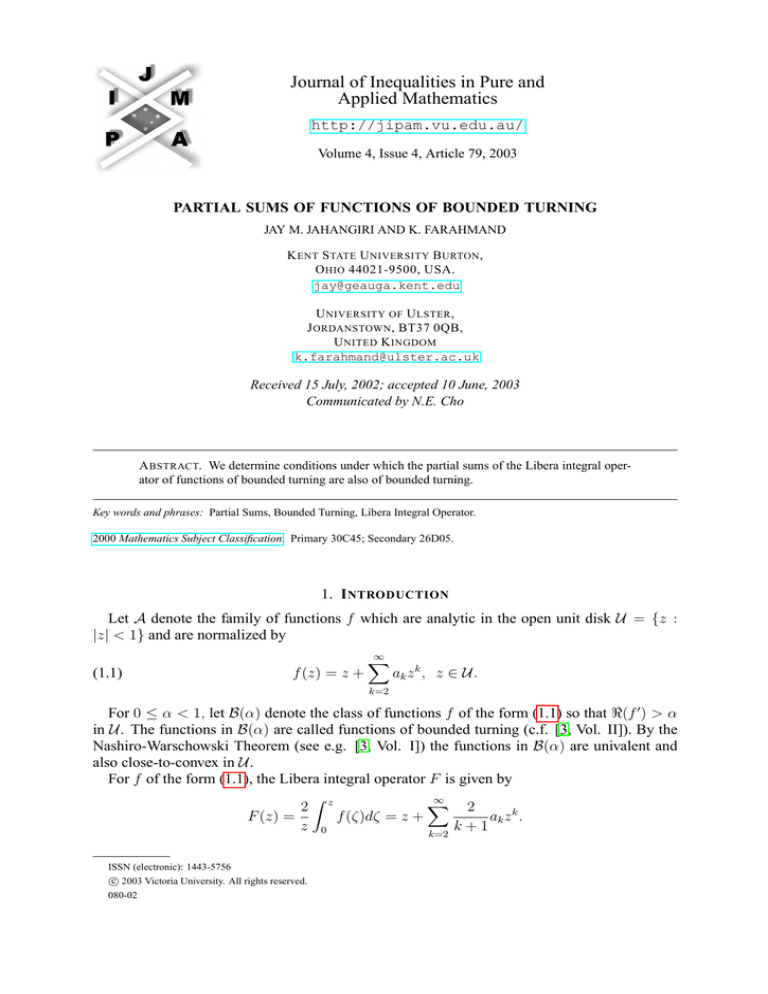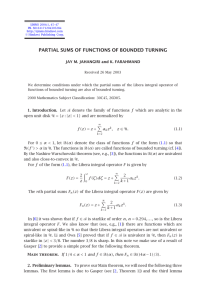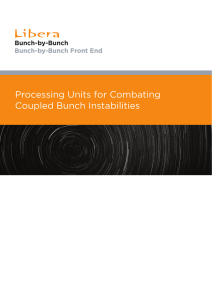
Journal of Inequalities in Pure and
Applied Mathematics
http://jipam.vu.edu.au/
Volume 4, Issue 4, Article 79, 2003
PARTIAL SUMS OF FUNCTIONS OF BOUNDED TURNING
JAY M. JAHANGIRI AND K. FARAHMAND
K ENT S TATE U NIVERSITY B URTON ,
O HIO 44021-9500, USA.
jay@geauga.kent.edu
U NIVERSITY OF U LSTER ,
J ORDANSTOWN , BT37 0QB,
U NITED K INGDOM
k.farahmand@ulster.ac.uk
Received 15 July, 2002; accepted 10 June, 2003
Communicated by N.E. Cho
A BSTRACT. We determine conditions under which the partial sums of the Libera integral operator of functions of bounded turning are also of bounded turning.
Key words and phrases: Partial Sums, Bounded Turning, Libera Integral Operator.
2000 Mathematics Subject Classification. Primary 30C45; Secondary 26D05.
1. I NTRODUCTION
Let A denote the family of functions f which are analytic in the open unit disk U = {z :
|z| < 1} and are normalized by
(1.1)
f (z) = z +
∞
X
ak z k , z ∈ U.
k=2
For 0 ≤ α < 1, let B(α) denote the class of functions f of the form (1.1) so that <(f 0 ) > α
in U. The functions in B(α) are called functions of bounded turning (c.f. [3, Vol. II]). By the
Nashiro-Warschowski Theorem (see e.g. [3, Vol. I]) the functions in B(α) are univalent and
also close-to-convex in U.
For f of the form (1.1), the Libera integral operator F is given by
Z
∞
X
2 z
2
F (z) =
f (ζ)dζ = z +
ak z k .
z 0
k
+
1
k=2
ISSN (electronic): 1443-5756
c 2003 Victoria University. All rights reserved.
080-02
2
JAY M. JAHANGIRI AND K. FARAHMAND
The n-th partial sums Fn (z) of the Libera integral operator F (z) are given by
Fn (z) = z +
n
X
k=2
2
ak z k .
k+1
In [5] it was shown that if f ∈ A is starlike of order α, α = 0.294..., then so is the Libera
integral operator F. We also know that (see e.g. [1]), there are functions which are univalent
or spiral-like in U so that their Libera integral operators are not univalent or spiral-like in U.
Li and Owa [4] proved that if f ∈ A is univalent in U, then Fn (z) is starlike in |z| < 83 . The
number 38 is sharp. In this paper we make use of a result of Gasper [2] to provide a simple proof
for the following theorem.
Theorem 1.1 (Main Theorem). If 14 ≤ α < 1 and f ∈ B(α), then Fn ∈ B 4α−1
.
3
2. P RELIMINARY L EMMAS
To prove our Main Theorem, we shall need the following three lemmas. The first lemma is
due to Gasper ([2, Theorem 1]) and the third lemma is a well-known and celebrated result (c.f.
[3, Vol. I]) which can be derived from Herglotz’s representation for positive real part functions.
Lemma 2.1. Let θ be a real number and m and k be natural numbers. Then
m
1 X cos(kθ)
(2.1)
+
≥ 0.
3 k=1 k + 2
Lemma 2.2. For z ∈ U we have
m
X
zk
<
k+2
k=1
!
1
>− .
3
Proof. For 0 ≤ r < 1 and for 0 ≤ |θ| ≤ π write z = reiθ = r(cos(θ)+i sin(θ)). By DeMoivre’s
law and the minimum principle for harmonic functions, we have
!
m
m
m
k
X
X
z
rk cos(kθ) X cos(kθ)
=
>
.
(2.2)
<
k+2
k+2
k+2
k=1
k=1
k=1
Now by Abel’s lemma (c.f. Titchmarsh [6]) and condition (2.1) of Lemma 2.1 we conclude that
the right hand side of (2.2) is greater than or equal to −1
.
3
Lemma 2.3. Let P (z) be analytic in U, P (0) = 1, and <(P (z)) > 12 in U. For functions Q
analytic in U the convolution function P ∗ Q takes values in the convex hull of the image on U
under Q.
operator “∗” stands
for the Hadamard product or convolution
power series f (z) =
PThe
P∞
P∞ of two
∞
k
k
k
a
z
and
g(z)
=
b
z
denoted
by
(f
∗
g)(z)
=
a
b
z
.
k=1 k
k=1 k
k=1 k k
3. P ROOF OF THE M AIN T HEOREM
≤ α < 1. Since <(f 0 (z)) > α we have
!
∞
X
1
1
< 1+
kak z k−1 > .
2(1 − α) k=2
2
Let f be of the form (1.1) and belong to B(α) for
(3.1)
J. Inequal. Pure and Appl. Math., 4(4) Art. 79, 2003
1
4
http://jipam.vu.edu.au/
PARTIAL S UMS OF F UNCTIONS OF B OUNDED T URNING
3
Applying the convolution properties of power series to Fn0 (z) we may write
n
X
2k
0
Fn (z) = 1 +
(3.2)
ak z k−1
k
+
1
k=2
!
!
∞
n
X
X
4
1
kak z k−1 ∗ 1 + (1 − α)
= 1+
z k−1
2(1 − α) k=2
k
+
1
k=2
= P (z) ∗ Q(z).
From Lemma 2.2 for m = n − 1 we obtain
!
n
X
z k−1
1
(3.3)
<
>− .
k+1
3
k=2
Applying a simple algebra to the above inequality (3.3) and Q(z) in (3.2) yields
!
n
X
4 k−1
4α − 1
<(Q(z)) = < 1 + (1 − α)
z
>
.
k
+
1
3
k=2
On the other hand, the power series P (z) in (3.2) in conjunction with the condition (3.1) yields
<(P (z)) > 12 . Therefore, by Lemma 2.3, <(Fn0 (z)) > 4α−1
. This concludes the Main Theorem.
3
Remark 3.1. The Main Theorem also holds for α < 41 . We also note that B(α) for α < 0 is no
longer a bounded turning family.
R EFERENCES
[1] D.M. CAMPBELL AND V. SINGH, Valence properties of the solution of a differential equation,
Pacific J. Math., 84 (1979), 29–33.
[2] G. GASPER, Nonnegative sums of cosines, ultraspherical and Jacobi polynomials, J. Math. Anal.
Appl., 26 (1969), 60–68.
[3] A.W. GOODMAN, Univalent Functions, Vols. I & II, Mariner Pub. Co., Tampa, FL., 1983.
[4] J.L. LI AND S. OWA, On partial sums of the Libera integral operator, J. Math. Anal. Appl., 213
(1997), 444–454.
[5] P.T. MOCANU, M.O. READE AND D. RIPEANU, The order of starlikeness of a Libera integral
operator, Mathematica (Cluj), 19 (1977), 67–73.
[6] E.C. TITCHMARSH, The Theory of Functions, 2nd Ed., Oxford University Press, 1976.
J. Inequal. Pure and Appl. Math., 4(4) Art. 79, 2003
http://jipam.vu.edu.au/







